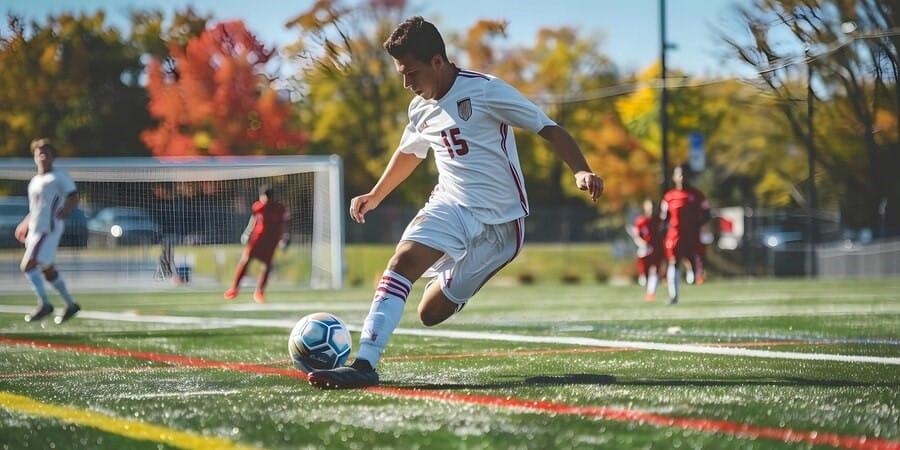
A young soccer player executes a kick during a match on an autumn day, showcasing his skills on the field.
The Science Behind Surface-Related Injuries
The debate between artificial turf and natural grass has divided soccer communities for decades, but nowhere is this discussion more critical than in college soccer. Young athletes face injury risks that could end their careers before they truly begin, making the choice of playing surface a crucial decision for programs nationwide.
Recent data paints a concerning picture. A comprehensive study examining high school soccer players found that ACL injuries occurred significantly more frequently on artificial turf compared to natural grass. Female soccer players experienced ACL injuries 53% more often on artificial surfaces, while male players showed similar trends, though results weren’t statistically significant.
The biomechanics explain these troubling statistics. Research indicates that higher rotational forces and increased cleat-surface traction on artificial turf create conditions that elevate ACL injury risk. Unlike natural grass, which provides give during sudden movements, artificial turf can lock the foot in place while the body continues rotating—a perfect storm for ligament damage.
Athletes Speak Out: The Player Perspective
Players themselves have become increasingly vocal about surface preferences. While specific college soccer surveys remain limited, professional athletes have made their stance clear. A 2024 survey revealed that 92% of professional football players prefer playing on grass rather than turf. This overwhelming preference stems from both injury concerns and performance factors that directly impact the college soccer experience.
The message from athletes is consistent: natural grass feels better underfoot, allows for more natural movement patterns, and reduces the jarring impact that comes with every step on harder artificial surfaces.
Common Turf-Related Injuries Plaguing College Soccer
The most infamous injury associated with artificial turf remains “turf toe.” This condition, recently exemplified by professional athlete Joe Burrow’s experience, involves damage to the ligaments surrounding the big toe joint. Grade 3 turf toe injuries can sideline athletes for months and are particularly prone to re-injury, requiring extensive rehabilitation.
Beyond turf toe, artificial surfaces contribute to increased rates of several other injuries. ACL and knee ligament tears top the list, followed by ankle sprains and strains. Players also report higher incidences of hip and lower back stress from the harder surface impact, along with painful abrasion injuries from sliding tackles that wouldn’t occur on natural grass.
The Economic Reality Behind Surface Choices
Despite mounting injury concerns, many colleges continue installing artificial turf fields, driven primarily by economics. Natural grass demands constant maintenance, irrigation, fertilization, and periodic re-sodding—expenses that strain athletic department budgets. Artificial turf promises year-round playability and significantly lower maintenance costs, making it attractive for cash-conscious programs.
However, these apparent savings mask hidden costs. Medical expenses from increased injuries, lost playing time affecting team performance, and potential impacts on athletic scholarships and professional prospects represent substantial financial burdens not captured in simple maintenance comparisons. When a single ACL surgery can cost upwards of $50,000, the economics become less clear-cut.
Innovation on the Horizon
The artificial turf industry has responded to injury concerns with significant technological advances. Modern systems incorporate shock-absorbing underlays, improved infill materials like cork and coconut fibers, and advanced synthetic grass blades designed to better mimic natural grass movement.
Hybrid systems combining natural grass with synthetic fiber reinforcement represent an emerging compromise. These fields offer enhanced durability while maintaining many injury-prevention characteristics of natural grass. European soccer clubs have pioneered these systems, reporting positive results in both playability and injury reduction.
Practical Steps for College Programs
College soccer programs must navigate this complex landscape thoughtfully. First, prioritizing player safety means treating natural grass as the gold standard whenever financially feasible. For programs requiring artificial surfaces, investing in the highest-quality systems with proven injury-reduction features becomes essential.
Training protocols need adaptation when artificial turf is unavoidable. Teams should implement targeted injury prevention exercises focusing on knee stability and ankle strength. Recovery periods between high-intensity sessions may need extension to account for increased joint stress.
Systematic injury tracking across different surfaces helps programs make data-driven decisions. While some studies suggest similar overall injury rates between surfaces, the specific risk of severe injuries like ACL tears appears consistently elevated on artificial turf—a distinction that matters immensely for young athletes.
The Path Forward
The evidence is clear: playing surface choice significantly impacts injury risk in college soccer. As programs balance budgets with athlete welfare, the true cost of artificial turf extends far beyond installation and maintenance figures. Every ACL tear, every extended rehabilitation, and every shortened career represents both human and financial costs that demand consideration.
The college soccer community must unite around player safety as the paramount concern. Whether through continued investment in natural grass maintenance, adoption of cutting-edge hybrid surfaces, or development of safer artificial alternatives, protecting the next generation of soccer talent requires action today. The surface beneath a player’s boots might seem like infrastructure minutiae, but for athletes whose futures depend on staying healthy, it represents one of the most critical factors in their athletic journey.

